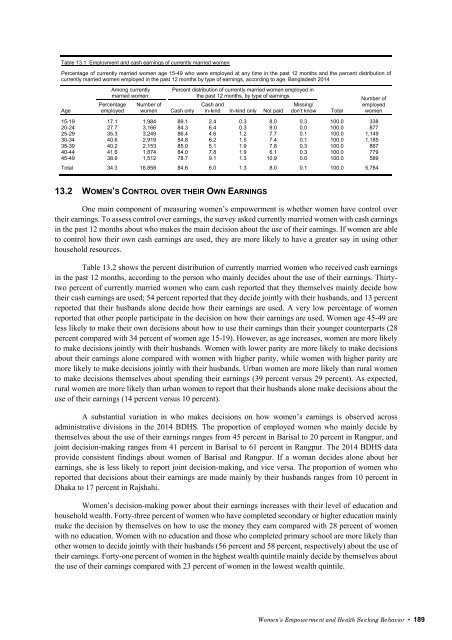Bangladesh 2014
8ln3LMTjp
8ln3LMTjp
You also want an ePaper? Increase the reach of your titles
YUMPU automatically turns print PDFs into web optimized ePapers that Google loves.
Table 13.1 Employment and cash earnings of currently married women<br />
Percentage of currently married women age 15-49 who were employed at any time in the past 12 months and the percent distribution of<br />
currently married women employed in the past 12 months by type of earnings, according to age, <strong>Bangladesh</strong> <strong>2014</strong><br />
Age<br />
Among currently<br />
married women:<br />
Percentage<br />
employed<br />
Number of<br />
women<br />
Percent distribution of currently married women employed in<br />
the past 12 months, by type of earnings<br />
Cash only<br />
Cash and<br />
in-kind In-kind only Not paid<br />
Missing/<br />
don’t know<br />
Total<br />
Number of<br />
employed<br />
women<br />
15-19 17.1 1,984 89.1 2.4 0.3 8.0 0.3 100.0 338<br />
20-24 27.7 3,166 84.3 6.4 0.3 9.0 0.0 100.0 877<br />
25-29 35.3 3,249 86.4 4.6 1.2 7.7 0.1 100.0 1,149<br />
30-34 40.6 2,919 84.8 6.2 1.5 7.4 0.1 100.0 1,185<br />
35-39 40.2 2,153 85.0 5.1 1.9 7.8 0.3 100.0 867<br />
40-44 41.6 1,874 84.0 7.8 1.9 6.1 0.3 100.0 779<br />
45-49 38.9 1,512 78.7 9.1 1.3 10.9 0.0 100.0 589<br />
Total 34.3 16,858 84.6 6.0 1.3 8.0 0.1 100.0 5,784<br />
13.2 WOMEN’S CONTROL OVER THEIR OWN EARNINGS<br />
One main component of measuring women’s empowerment is whether women have control over<br />
their earnings. To assess control over earnings, the survey asked currently married women with cash earnings<br />
in the past 12 months about who makes the main decision about the use of their earnings. If women are able<br />
to control how their own cash earnings are used, they are more likely to have a greater say in using other<br />
household resources.<br />
Table 13.2 shows the percent distribution of currently married women who received cash earnings<br />
in the past 12 months, according to the person who mainly decides about the use of their earnings. Thirtytwo<br />
percent of currently married women who earn cash reported that they themselves mainly decide how<br />
their cash earnings are used; 54 percent reported that they decide jointly with their husbands, and 13 percent<br />
reported that their husbands alone decide how their earnings are used. A very low percentage of women<br />
reported that other people participate in the decision on how their earnings are used. Women age 45-49 are<br />
less likely to make their own decisions about how to use their earnings than their younger counterparts (28<br />
percent compared with 34 percent of women age 15-19). However, as age increases, women are more likely<br />
to make decisions jointly with their husbands. Women with lower parity are more likely to make decisions<br />
about their earnings alone compared with women with higher parity, while women with higher parity are<br />
more likely to make decisions jointly with their husbands. Urban women are more likely than rural women<br />
to make decisions themselves about spending their earnings (39 percent versus 29 percent). As expected,<br />
rural women are more likely than urban women to report that their husbands alone make decisions about the<br />
use of their earnings (14 percent versus 10 percent).<br />
A substantial variation in who makes decisions on how women’s earnings is observed across<br />
administrative divisions in the <strong>2014</strong> BDHS. The proportion of employed women who mainly decide by<br />
themselves about the use of their earnings ranges from 45 percent in Barisal to 20 percent in Rangpur, and<br />
joint decision-making ranges from 41 percent in Barisal to 61 percent in Rangpur. The <strong>2014</strong> BDHS data<br />
provide consistent findings about women of Barisal and Rangpur. If a woman decides alone about her<br />
earnings, she is less likely to report joint decision-making, and vice versa. The proportion of women who<br />
reported that decisions about their earnings are made mainly by their husbands ranges from 10 percent in<br />
Dhaka to 17 percent in Rajshahi.<br />
Women’s decision-making power about their earnings increases with their level of education and<br />
household wealth. Forty-three percent of women who have completed secondary or higher education mainly<br />
make the decision by themselves on how to use the money they earn compared with 28 percent of women<br />
with no education. Women with no education and those who completed primary school are more likely than<br />
other women to decide jointly with their husbands (56 percent and 58 percent, respectively) about the use of<br />
their earnings. Forty-one percent of women in the highest wealth quintile mainly decide by themselves about<br />
the use of their earnings compared with 23 percent of women in the lowest wealth quintile.<br />
Women’s Empowerment and Health Seeking Behavior • 189


